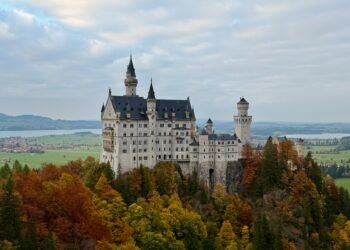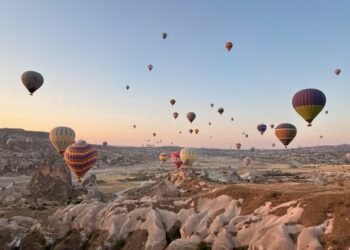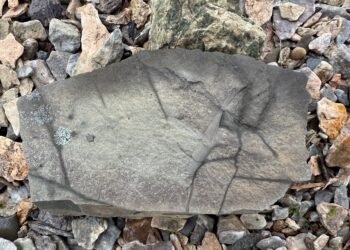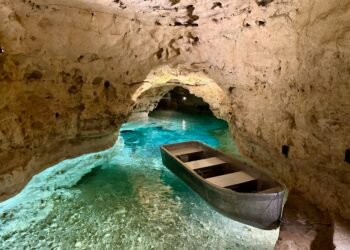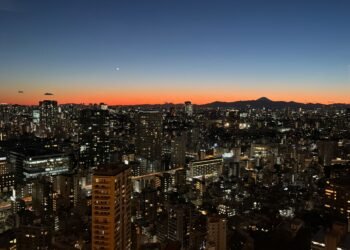In this article, I recount my long-awaited journey to the ancient city of Petra, Jordan—a UNESCO World Heritage site known for its breathtaking architecture and historical significance. Blending personal experiences with Petra’s rich history, geology, and the ingenious water engineering of the Nabateans, I explore what makes this “Rose City” so extraordinary. From the vibrant streets of Amman to the awe-inspiring Treasury and the hidden cave dwellings carved into the cliffs, Petra unfolds as a place where nature and human ingenuity converge in timeless beauty. Join me as I walk through Petra’s storied past, experiencing firsthand the wonder of this desert marvel.
1 Introduction
My journey to Jordan was a dream realized—a dream that began with childhood awe. I still remember flipping through the pages of National Geographic, completely captivated by images of an ancient city carved from vibrant red cliffs. Petra, with its legendary architecture and mystery, lodged itself in my imagination, calling me to experience its depths firsthand. I was especially enchanted by Petra’s Treasury, Al-Khazneh, famously framed by the narrow, winding passage of the Siq—an ancient gorge created by tectonic forces and erosion over eons. From those pages, Petra’s allure grew, drawing me in not only with its beauty but also with a curiosity about the science behind its creation.
In January, I finally touched down in Amman, Jordan, set to explore both Petra and the Dead Sea. This was my second time in the Middle East—my first being in Egypt—and despite the region’s current unrest, my excitement remained undeniable. I contacted my Airbnb host for some help getting from the airport, as I anticipated that it would be challenging, being new to the country. He offered to arrange a private driver—a perfect solution for navigating the city’s bustling roads. And soon, I was off, ready for a journey filled with both discovery and adventure.
Before finally arriving in Jordan, my travels had already taken me to some of the world’s most iconic archaeological marvels. I’ve trekked the sacred Inca trails of Machu Picchu, stood in awe of the towering Great Pyramid of Giza, and marvelled at the architectural ingenuity of the Pyramid of Djoser. Each of these destinations, like Petra, tells a story of human ambition, resilience, and a deep connection with the land. You can also read about my adventure to the Dead Sea.
2 Quick Facts About Petra
- Location: Near Wadi Musa in southern Jordan, roughly 240 km (150 miles) south of Amman.
- Name Origin: “Petra” comes from the Greek word for “rock,” reflecting its unique rock-cut architecture.
- Founding Civilization: Built by the Nabateans, an Arab people who settled in the region more than 2,000 years ago.
- Cultural Peak: At its height, Petra was a thriving trading hub linking Arabian, Egyptian, and Mediterranean trade routes.
- Rediscovery: Western explorers first documented Petra in 1812, thanks to Johann Ludwig Burckhardt, rekindling global interest in the ancient city.
- UNESCO Status: Inscribed as a World Heritage Site in 1985 for its cultural, historical, and architectural significance.
- Famous Monument: The Treasury (Al-Khazneh) is Petra’s most iconic structure, known for its intricate façade carved directly into the sandstone cliffs.
- Geology: Petra’s red, pink, and orange hues come from iron oxides and other minerals in the sandstone; the site also highlights tectonic formations and water erosion processes.
- Water Engineering: The Nabateans built sophisticated channels, pipes, and reservoirs to manage scarce water resources in the arid desert environment.
- Petra by Night: A special event where the Siq and the Treasury are lit by candles, offering a unique and atmospheric way to experience the site.
3 Explore Petra: Map of the Region
4 Arrival in Amman
Amman greeted me with a surprising chill; January temperatures hovered around 17–18°C in the day and dipped to around 10°C at night—a far cry from the warm climate I’d expected. But the cool air invigorated me as I set out to explore Jordan’s capital. Amman is a lively city, its streets alive with history and modern energy—a crossroads of ancient and contemporary cultures. I spent the day weaving through markets, sampling Jordan’s delicious local dishes, and speaking with friendly locals who seemed delighted to share their country with a visitor. As the rain began to fall, I found a cozy restaurant in the Prince Mohammad Street area, where I enjoyed a flavorful meal of grilled chicken and rice, complemented by warm flatbread.
One detail that surprised me was Amman’s hills—climbing back to my accommodation felt like a small hike in itself! These hills, I later learned, are part of the rugged Transjordan Plateau, a geological formation that speaks to Jordan’s diverse landscape. It reminded me that my upcoming journey would be a true exploration, from Amman’s hilltop views to Petra’s canyoned corridors and desert expanses.
As I walked back through Amman’s nighttime vibrancy, I felt deeply connected to a place I’d long dreamed of. Amman was just the beginning, but it already felt like I was rediscovering fragments of my own childhood curiosity with each step. My thoughts drifted to Petra, the crown jewel of my trip, where the blending of natural and human wonders would be on full display.
5 Journey to Petra
After a full day exploring Amman, I was ready to embark on the drive south to Petra. My driver picked me up at 7:30 a.m., and we began the three-hour journey to Wadi Musa, the town that serves as Petra’s gateway. As we left the city behind, the scenery changed dramatically, giving way to Jordan’s rugged desert landscape. I watched the horizon as flat expanses of sand stretched out, punctuated by distant mountains and the occasional caravan of camels. The vastness was humbling, and the quiet beauty of the landscape seemed to mirror the timeless mystery of Petra itself.
We made a brief stop at Mousa’s Spring, a site said to be where the Prophet Moses struck a rock to bring forth water. The historical resonance of the spring, combined with the natural surroundings, reminded me how deeply history and landscape are intertwined in this region. The desert, for all its harshness, holds pockets of life, sustained by the very elements that seem to work against it.
My driver, perhaps sensing my excitement, shared traditional Jordanian songs as we drove and spoke about how recent regional unrest had impacted tourism and his business. His stories added a layer of context, reminding me that Petra isn’t only an ancient wonder but also a place that lives and breathes in the present.

By 11 a.m., we reached the entrance to Petra. I felt a thrill in the air as I stood at the front gate, looking out over the red sandstone cliffs—finally about to step into a place I had dreamed about since childhood.
6 Walking Through the Siq
Entering Petra begins with a walk through the Siq, the winding gorge that leads into the city’s heart. The Siq itself is a marvel of natural forces. Formed by tectonic shifts millions of years ago and further shaped by water erosion, the gorge serves as both a grand entryway and a testament to nature’s artistic hand. As I walked along the path, I was captivated by the towering rock walls, painted in hues of red, orange, and yellow. It felt like stepping into a different world, where every layer of stone told a story of eons past.

The Nabateans, masters of harnessing Petra’s natural features, carved water channels along the Siq to guide rainwater away from the gorge, reducing the risk of flash floods. This ingenious engineering, thousands of years old, is still visible today. The channels, carved along the base of the rock walls, remind us of the Nabateans’ deep understanding of Petra’s landscape and their determination to thrive in it. It’s remarkable to think that this city, so deeply embedded in the desert, was once a bustling hub of life, largely because of the Nabateans’ mastery over water.
As I walked further, the rhythmic echo of horses’ hooves filled the air, their steady clip-clop punctuating the canyon’s hush. I spotted police officers patrolling on horseback, and I felt a sense of safety as I ventured deeper. The narrowness of the passage, with walls that seemed to close in, heightened the anticipation of what lay ahead.

7 The Treasury (Al-Khazneh): A First Look
And then, finally, I turned the last corner of the Siq and saw it—the Treasury, Al-Khazneh. The sight was breathtaking. The intricate façade, carved directly from the rock, loomed before me, bathed in the morning light. Seeing it in person was far more powerful than any photograph could convey. The sandstone glowed in shades of rose and coral, and every column, capital, and niche seemed alive with stories waiting to be uncovered.
View this post on Instagram
The Treasury’s function remains a mystery, though historians suggest it may have been a royal tomb or a temple. Its design, influenced by Greek and Roman styles, reflects the cosmopolitan culture of Petra’s golden age. It’s hard not to be awestruck by the Nabateans’ artistry and ambition. To create such a structure in the heart of the desert speaks to their dedication and skill, as well as their willingness to push the limits of architecture and engineering.
“Petra is a city born of resilience and innovation, carved from rock but imbued with a vibrancy that echoes through time.”
I stood there for a while, marveling at the details—each carving more intricate than the last. In that moment, I felt connected to the Nabateans—not just as historical figures but as people who lived, dreamed, and built something extraordinary. As I turned to continue deeper into the city, I could only imagine what other wonders Petra had in store.
8 Exploring Petra’s Cave Dwellings
Continuing beyond the Treasury, Petra began to reveal more of its secrets. Dotting the sandstone cliffs were countless caves, their entrances dark against the vibrant red rock. These dwellings, carved directly into the canyon walls, once served as homes and shelters for Petra’s inhabitants. I wandered into one of these caves, marveling at the layout—small rooms carved with surprising depth and precision, likely intended to protect residents from the sun’s harsh heat and the desert’s chill nights.

The Nabateans, it seemed, crafted an entire city within these cliffs. I could imagine life here: families gathering in the cool stone shade, children playing in the canyons, traders sharing stories of distant lands. The quiet, earthy scent of the sandstone enveloped me as I explored, and I could almost sense the presence of those who once called this place home.

It was astonishing to think that so much life could be sustained in such an unforgiving environment. The Nabateans’ approach—integrating their homes into the landscape—was both practical and sustainable, reflecting a people who lived in harmony with the land rather than against it.
9 The Nabatean Theatre: A Glimpse of Petra’s Cultural Heart
Further along, I arrived at Petra’s Roman-style theatre—often called the Nabatean Theatre. Carved directly into the rock, this amphitheater could seat thousands, suggesting a bustling, thriving hub of cultural activity. The Nabateans built it before the Romans arrived, showing that they had already embraced performance and public gatherings.

Standing before the amphitheater, I could envision the gatherings that must have taken place here—performances, community meetings, or ceremonial events. The seating, still intact, cascades up the hillside in neatly carved rows. Petra was not just a place of trade and survival but also a city built to flourish in spirit.
Like the water channels and the cave dwellings, the theatre reflects the Nabateans’ skill in adapting to their environment. The rock itself served as both structure and a natural amplifier, blending architecture and acoustics under an open sky. It felt like an echo of the Nabateans themselves—rooted in the landscape, resilient, and resourceful.
10 Reflecting on Petra: The Journey Back
As I made my way back through the Siq, the afternoon light painted the walls in warm hues, as if bidding me farewell. I felt an overwhelming sense of fulfillment—Petra was everything I had imagined and more. A city born of resilience and innovation, carved from rock but imbued with vibrancy. I left Petra with my mind filled with images of grand stone facades, water channels, and amphitheaters, wondering what it would have been like to see Petra in its prime.
Back in Wadi Musa, I stopped at a small roadside café for a cup of sage tea—chai maramiyya. Warm and earthy, the tea felt like a fitting end to my journey, embodying Jordan’s depth and hospitality. As my driver and I headed back to Amman, Petra stayed with me—not just as rocks and ruins, but as a living testament to what people can achieve through determination and harmony with the land. The Nabateans didn’t just survive; they thrived, transforming Petra into a place of wonder that still inspires awe millennia later.

11 Practical Tips for Visiting Petra
Visiting Petra is an unforgettable experience, and a little preparation can enhance your trip:
- Best Time to Visit: March to May and September to November for mild temperatures.
- Tickets and Entrance Fees: Entrance fees help preservation. A one-day ticket costs about 50 JOD; two- or three-day passes are also available.
- Start Early: Arrive at opening time to see the Treasury in soft morning light and beat the crowds.
- Wear Comfortable Shoes & Bring Essentials: Expect rugged paths. Bring water, sunscreen, a hat, and snacks.
- Plan Your Route: The Siq and Treasury are must-sees. If you have time, hike to the Monastery (Ad-Deir) for a more secluded experience.
- Stay Overnight in Wadi Musa: Many accommodation options allow you to explore Petra early and avoid midday heat.
- Consider a Guided Tour: Local guides can offer deep insights into Petra’s history, geology, and Nabatean culture.
- Respect the Site: Petra is protected by UNESCO—avoid touching or climbing on monuments.
- Cash is King: Carry Jordanian Dinar for small vendors and tips.
- Evening Visits: “Petra by Night” illuminates the Siq and Treasury with candles, creating a magical ambiance.
- Best Photo Spots & Times:
- Treasury in early morning or late afternoon
- Monastery mid-morning
- Royal Tombs in late afternoon
- For unique views, hike above the Treasury or attend Petra by Night
12 Pro Tips for the Science Traveler
For those delving into Petra’s scientific and engineering marvels:
- Observe Petra’s Geology: Check out the colored layers in the sandstone, revealing millions of years of Earth’s history.
- Explore Water Management: Look for ancient channels and cisterns; they showcase Nabatean mastery of scarce desert water.
- Consider Celestial Alignments: Some monuments may align with solstices or equinoxes. Research beforehand for a new perspective.
- Stargazing: Minimal light pollution near Petra makes for excellent night-sky viewing.
- Bring Binoculars: Examine rock carvings and higher formations more closely.
- Use Geology or Archaeology Apps: Try tools like Rockd, Petra Jordan, or The Petra Museum app for on-site insights.
- Visit the Petra Museum: Near the entrance, it offers a deeper look at Nabatean artifacts and geology.
- Connect with Local Experts: Opt for a guide specializing in Petra’s geology and archaeology to go beyond standard historical tours.
13 Final Thoughts
Petra’s allure goes beyond its striking sandstone structures and ancient tombs. It stands as a testament to human resilience and ingenuity—an intersection of geology, engineering, and cultural evolution. Whether you’re drawn by its science, history, or breathtaking beauty, Petra promises an experience that lingers long after you’ve left its canyon walls.
Ready to Share Your Experience?
If Petra is on your bucket list—or if you’ve already explored its desert pathways—I’d love to hear your thoughts. Leave a comment or check out my other adventures at Machu Picchu, the Great Pyramid of Giza, and the Pyramid of Djoser for more inspiring journeys where history and science meet.


